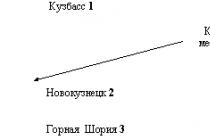More than 200 years passed since the steam tracts were invented. Since then, railway transport has become the most demanded for the transport of passengers and goods. However, scientists actively worked on the improvement of this method of movement. As a result, Maglev was created or the train on magnetic pillows.

The idea appeared at the beginning of the twentieth century. But it was not possible to realize it at that time. And only in the late 60s - early 70s in Germany gathered a magnetic route, where they launched a new generation vehicle. Then he moved at a speed of a maximum of 90 km / h and only 4 passengers could accommodate. In 1979, the train on magnetic pillows was upgraded, and he was able to transport 68 passengers, driving 75 kilometers per hour. And at the same time, in Japan, a different variation of Maglev was constructed. He accelerates to 517 km / h.
Today, the rapidness of trains on magnetic pillows can be a real competition to aircraft. Magnetoplan could seriously compete with air carriers. The only obstacle is that maglevia is not capable of sliding along ordinary railways. They require special highways. In addition, it is believed that the necessary trains on an air cushion Magnetic field can have an adverse effect on a healthier person.
Magnetoplan is not moving along the rails, he flies in the literal sense of the word. At low height (15 cm) from the surface of the magnetic route. He rises above the track due to the action of electromagnets. This explains the incredible speed.
The canvas for Maglava looks like a series of concrete slabs. Magnets are located under this surface. They artificially create a magnetic field for which the train "goes". During movement there is no friction, so aerodynamic resistance is used for braking.
If in a simple language explain the principle of operation, then it will turn out. When a couple of magnets brought to each other with the same poles, they seem to be repelled one from the other. It turns out a magnetic pillow. And when approaching the opposite poles, the magnets are attracted, and the train stops. Such an elementary principle is based on the operation of the magnetoplane, which moves through the air at low height.
Today we use 3 magtel suspension technologies.

1. Electrodynamic suspension, EDS.
Otherwise, this is called superconducting magnets, that is, on variations with winding from superconducting material. Such a winding has zero ohmic resistance. And if it is closed in short, the electric current in it is preserved infinitely long.
2. Electromagnetic suspension, EMS (or on electromagnets).
3. On permanent magnets. Today is the least costly technology. The process of movement is provided by a linear engine, that is, an electric motor, where one element of the magnetic system is open and has an expanded winding that creates a running magnetic field, and the second is made as a guide that is responsible for the linear movement of the moving part of the engine.
Many think: is it a safe train, it will not fall? Of course, it will not fall. It is impossible to say that Maglev does not hold anything on the road. It relies on the track through special "claws", located at the bottom of the train, in which electromagnets are delivered, lifting the train into the air. There are also those magnets that hold magnetoplan on the track.
Those who swept on Maglev, argue that nothing inspiring did not feel. The train is so quiet that the breathtaking speed is not felt. Objects outside the window flush quickly, but are located very far from the track. The magnetoplan accelerates smoothly, so the overload is also not felt. Interesting and unusual only moment when the train rises.
So, the main advantages of Magleva:

- the maximum possible speed of movement, which is achieved on ground (unsportsbital) transport,
- a small amount of electricity is required,
- due to the lack of friction, small-time maintenance,
- quiet movement.
Disadvantages:
- the need for large financial costs in the construction and maintenance of the track,
- the electromagnetic field can harm the health of those who work on these lines and lives in the surrounding areas,
- for permanent control of the distance between the train and the track, high-speed management systems and heavy-duty instruments are required,
- a difficult pathway scheme and road infrastructure are required.
Trains on a magnetic pillow, Maglev are the fastest kind of ground public transport. And although only three small tracks, research and testing prototypes of magnetic trains are introduced while different countriesoh. How magnetic levitation technology developed and what awaits it in the near future you will learn from this article.
The first pages of Maglev's history were filled with rows of patents obtained at the beginning of the 20th century in different countries. Back in 1902, the Patent on the construction of the train equipped with a linear engine was noted by the German inventor of Alfred Zeiden. And already four years later, Franklin Scott Smith developed another early prototype of the train on an electromagnetic suspension. A little later, in the period from 1937 to 1941, a few more patents related to trains equipped with linear electric motors, he received the German engineer Herman Cerma. By the way, the moving formulations of the Moscow Monorail Transport System, built in 2004, use asynchronous linear engines to move - is the world's first monorail engine.
Train of the Moscow Montorels System near Tolerent Station
In the late 1940s, researchers switched from the word to the case. British engineer Eric Laceweet, whom many are called the "father of Magrelov", managed to develop the first working full-size prototype of a linear asynchronous engine. Later, in the 1960s, he joined the development of the Tracked HoverCraft speed train. Unfortunately, in 1973 the project was closed due to lack of funds.

In 1979, the world's first prototype in the magnetic cushion was appeared, licensed to provide passenger transport services - Transrapid 05. The test track of 908 m long was built in Hamburg and was presented during the exhibition IVA 79. The interest in the project was so great that transrapid 05 managed to successfully work out three months after the end of the exhibition and to transport about 50 thousand passengers a total. The maximum speed of this train was 75 km / h.

And the first commercial magnetoplan appeared in 1984 in Birmingham, England. The railway line on a magnetic suspension joined the terminal of Birmingham International Airport and a nearby railway station. She successfully worked from 1984 to 1995. The length of the line was only 600 m, and the height on which the composition with a linear asynchronous engine was raised above the pathway - 15 millimeters. In 2003, the AIRRAIL LINK passenger transport system based on Cable Liner technology was built in her place.
In the 1980s, not only in England and Germany, but also in Japan, Korea, China and the United States begged to develop and implement projects to create high-speed trains on the magnetic cushion.
How it works
We know about the basic properties of magnets since the lessons of physics for the 6th grade. If you bring the North Pole of the Permanent Magnet to the North Pole of another magnet, they will be repelled. If one of the magnets turn over, connecting different poles - attract. This simple principle is laid in magleval trains, which slide over the air over the rail at a small distance.
The magnetic suspension technology is based on three main subsystems: levitation, stabilization and acceleration. At the same time, currently there are two main magnetic suspension technologies and one experimental, proven only on paper.

Trains built on the basis of electromagnetic suspension technology (EMS) for levitation use an electromagnetic field, which changes over time. At the same time, the practical implementation of this system is very similar to the work of ordinary railway transport. A T-shaped rail can be used here from the conductor (mainly metal), but the train instead of wheeled steam uses a system of electromagnets - reference and guides. The support and guide magnets are located in parallel to ferromagnetic stators placed on the edges of the T-shaped path. The main disadvantage of EMS technology is the distance between the support magnet and the stator, which is 15 millimeters and should be monitored and adjusted by special automated systems depending on the set of factors, including the non-perceptible nature of the electromagnetic interaction. By the way, the levitation system works due to batteries installed on board the trains, which are recharged by linear generators built into support magnets. Thus, in the event of a stop, the train will be able to levitate long enough on batteries. On the basis of EMS technology built TRANSRAPID trains and, in particular, Shanghai Maglev.

Trains based on EMS technology are driven and carry out braking using a synchronous linear low acceleration engine represented by supporting magnets and a web, over which heap magnetoplan. By and large, motor systemBuilt in the canvas is a conventional stator (the fixed part of the linear electric motor), deployed along the bottom of the web, and the reference electromagnets, in turn, operate as an anchor of the electric motor. Thus, instead of obtaining a torque, an alternating current in coils generates a magnetic field of excited waves, which moves the composition contactless. Changing the strength and frequency of alternating current allows you to adjust the traction and speed of the composition. At the same time, to slow down the move, you just need to change the direction of the magnetic field.

In the case of the use of electrodynamic suspension technology (EDS), levitation is carried out in the interaction of the magnetic field in the canvas and the field created by superconducting magnets on board the composition. On the basis of EDS technology built Japanese trains Jr-Maglev. In contrast to the EMS technology, in which conventional electromagnets and coils are applied, electricity is carried out only at the moment when power is supplied, superconducting electromagnets can carry out electricity even after the power supply has been disabled, for example, in the event of power outage. Cooling coils in the EDS system you can save a lot of energy. However, the cryogenic cooling system used to maintain more low temperatures In the coils, it may be quite expensive.

The main advantage of the EDS system is high stability - with a minor reduction in the distance between the web and magnets there is an outline strength that returns magnets to the original position, while at the same time, the increase in distance reduces the pushing force and increases the effect of attraction, which again leads to the system stabilization. In this case, no electronics for monitoring and adjusting the distance between the train and the web is required.
True, without flaws, there was also no - sufficient for levitation of the composition. The strength occurs only at high speeds. For this reason, the train on the EDS system must be equipped with wheels, which will be able to move at low speeds (up to 100 km / h). The corresponding changes should also be made along the entire length of the canvas, as the train may stop anywhere in connection with the technical fault.
Another disadvantage of EDS is that at low speeds in the front and rear parts of repulsive magnets in the canvas, the friction force arises, which acts against them. This is one of the reasons why the JR-Maglev refused to fully repulsive the system and looked towards the side levitation system.
It should also be noted that strong magnetic fields in the passenger sections generate the need to install magnetic protection. Without shielding a trip in such a car for passengers with an electronic heart stimulator or magnetic information carriers (HDD and credit cards), contraindicated.

The subsystem of acceleration in trains based on EDS technology works exactly as in the compositions based on EMS technology, except that, after changing the polarity, the states are stopped here for a moment.
The third, closest to the implementation of technology that exists so far only on paper is an EDS version with Inductrack permanent magnets, to activate which energy does not require. Until recently, the researchers believed that permanent magnets do not have sufficient trains to levitation. However, this problem was solved by placing magnets into the so-called "Halbach array". The magnets are located in such a way that the magnetic field occurs above the array, and not under it, and are able to maintain the levitation of the train at very low speeds - about 5 km / h. True, the cost of such arrays from permanent magnets is very high, therefore there is no single commercial project of this kind.
Guinness Book of Records

At the moment, the first line in the list of the fastest trains on the magnetic cushion is the Japanese solution JR-Maglev MLX01, which on December 2, 2003, on the test track in Yamanasi, managed to develop a record speed - 581 km / h. It is worth noting that JR-Maglev MLX01 has a few more records established from 1997 to 1999 - 531, 550, 552 km / h.

If you look at the nearest competitors, then among them it is worth noting the Shanghai Maglev Transrapid SMT, built in Germany, which was able to develop a speed of 501 km / h and its progenitor - Transrapid 07, overcoming the frontier 436 km / h more 1988.
Practical implementation

The train on the magnetic cushion Linimo, the operation of which began in March 2005, was developed by Chubu HSST and is still used in Japan. It runs between the two cities of the Aichi Prefecture. The length of the canvas over which Parian Maglev is about 9 km (9 stations). At the same time, the maximum speed of Linimo is 100 km / h. This did not prevent him from only during the first three months from the moment of launching to transport more than 10 million passengers.
Shanghai Maglev, created by the German company Transrapid and commissioned on January 1, 2004, is more famous. This railway line on a magnetic suspension connects the Station of the Shanghai Metro Lunyian Lu with international Airport Pudun. The total distance is 30 km, the train overcomes it in approximately 7.5 minutes, accelerating to the speed of 431 km / h.

Another railway line on a magnetic suspension is successfully operated in the city of Thajon, South Korea. UTM-02 became available to passengers on April 21, 2008, and on its development and creation took 14 years. The railway line on a magnetic suspension connects the National Museum of Science and Exhibition Park, the distance between which is only 1 km.
Among the trains on the magnetic cushion, the operation of which will begin in the near future, it is worth noting Maglev L0 in Japan, his tests were renewed quite recently. It is expected that by 2027 it will run along the Tokyo - Nagoya route.
Very expensive toy
Not so long ago, popular magazines called trains on a magnetic cushion with revolutionary transport, and the launch of new projects of such systems with enviable regularity was reported both private companies and authorities from different countries of the world. However, most of these grand projects were closed at the initial stages, and some railway lines on a magnetic suspension, though they had a short time for the benefit of the population, were later dismantled.
The main reason for the failure is that the train on the magnetic suspension is extremely roads. They require specially built under them from zero infrastructure, which, as a rule, is the most exempted article in the project budget. For example, Shanghai Maglev costs China at $ 1.3 billion or $ 43.6 million per 1 km of two-way web (including the cost of creating trains and stations building). Compete with train airlines on a magnetic cushion can only on longer routes. But again, there are enough places in the world with a large passenger traffic that is necessary in order for the railway line on a magnetic suspension.
What's next?

At the moment, the future of the trains on the magnetic suspension looks foggy to a greater extent due to the proceedable high cost of such projects and a long period of payback. At the same time, many countries continue to invest tremendous funds in projects to create high-speed railway highways (SMM). Not so long ago, speed tests of the train on the magnetic cushion Maglev L0 were resumed in Japan.
The Japanese government also hopes to be interested in their own trains on the US magnetic pillow. Recently, representatives of The Northeast Maglev, which plan to combine with the help of a railway line on Magnetic suspension Washington and New York, made an official visit to Japan. Perhaps the train on the magnetic suspension will get more distribution in countries with a less effective network of UNMD. For example, in the United States and the UK, but their cost will still remain high.
There is another event development scenario. As is known, one of the ways to increase the efficiency of trains on the magnetic cushion is the use of superconductors, which, when cooled to close to the absolute zero, temperatures completely lose electrical resistance. However, to keep huge magnets in pots with extremely cold liquids are very expensive, so to keep the desired temperature, you need huge "refrigerators", which increases even more costs.

But no one excludes the likelihood that in the near future, the luminais of physics will be able to create an inexpensive substance that retain superconducting properties even at room temperature. When achieving superconductivity at high temperatures, powerful magnetic fields capable of keeping the weight of the machine and trains will become so affordable that even "flying cars" will be economically beneficial. So we are waiting for news from laboratories.
Supporters of the widespread gauge managed to embody their projects into life on the railway laid by the Japanese at the beginning of the 30s. In colonized Southern Manchuria. In 1934, the legendary Asia-Express was launched between the cities of Dalian and Changchun (700 km), an indicative symbol of the Japanese imperialist power of that time. Causible to develop speed more than 130 km / h, he was much superior to China's railway system of that time, and even was much faster than the rapid express in Japan itself. And on the world scale "Asia-Express" had impressive characteristics. For example, the world's first air-conditioned wagons were equipped in it. The car-restaurant was equipped with refrigerators, there was also a special car - an overview area with windows throughout the perimeter, tinted with leather armchairs and bookshelves.
Probably, this example became the final argument in favor of a wide range and gave the beginning of the first projects of the rapid railway in Japan. In 1940, the Japanese government approved the project incredible on its scale. Already then the project assumed the creation of a train capable of developing speeds up to 200 km / h, but the Japanese government was not going to be limited to laying lines only in Japan. It was assumed to pave an underwater tunnel to the Korean Peninsula and stretching the way to Beijing. The construction has already been partially begun, but the war started soon and the ensuing deterioration of the military and political positions of Japan put an end to imperial ambitions. In 1943, the project was minimized, the same year became the last and for Asia-Express. Nevertheless, some sections of Sinkansen lines operated today were built in pre-war years.
The construction of "Sinkansen" was again spoken up 10 years after the war. Stormy economic growth has created a great demand for freight and passenger transportation in the country. However, the idea of \u200b\u200breviving the project was perfect unpopular and underwent sharp criticism. At that time, it was very believed that the auto and air transport displaces the railway soon, as it happened, for example, in the United States and some european countries. The project was at risk of breakdown again.
In 1958, between Tokyo and Osaka, the straight ancestor "Sinkansen" was launched between Tokyo and Osaka, the "Codama" business express. At maximum speed of 110 km / h, he overcomed the distance between cities in 6.5 hours, having made day trip. In Japan, where business culture is based on personal meetings, it was a very convenient solution. Nevertheless, he served at all long. The incredible popularity of "codes" did not leave any doubts about the need for high-speed lines, and in less than a year the government finally approved the construction project "Sinkansen".
The high-speed rail of railways in Japan is exactly what I dreamed of seeing my own eyes. These trains - bullets are shot from the platforms of Japanese stations every three minutes. Their average speed on the route is 270 km / h, the maximum and mention is not worth - the next records are too often fighting.
Under the Kat, a very small post about the main competitor to airfares and the most punctual passenger transport on the planet - Sinkansen.
The long-awaited acquaintance with the "Japanese miracle" took place at the station of Odavara, from where our journey through Japan is being trapped. Hikari No. 503 in just one and a half hours promised to deliver us to Kyoto.
1.
Sinkansen (Shinkansen) Literally with the Japanese - "New Top Line" is a common name of high-speed railways connecting the most important cities of Japan. The "new line" this road was called because Japanese builders for the first time when laying "Sinkansen" moved away from the practice of narrow splashes - the standard gauge width was 1435 mm. Prior to that, the entire Japanese railway network was a narrow scene (the width of the rut is 1067 mm).
2.
The first section of Sinkansen Tokyo-Osaka (Tokaido-Sinkansen) 515 km long was opened in 1964, on the eve of the opening of the XVIII Summer Olympiad in Tokyo. The first trains developed a speed of 220-230 km / h.
The network of high-speed lines is controlled by the Japan Railway GROUP Group. JR Group is the basis of Japan's railways network (controls 20135 out of 27268 km of roads, which is ~ 74% of all highways). It accounts for a large proportion of a long-distance and suburban railway. Initially, Sinkansen lines carried out freight and passenger transportation during the day and night. Now they serve only passengers, and in the period from midnight to 6 am, the movement stops for repair and preventive work. In Japan, there are quite a few night trains in Japan, and they still go along the old railway, the path of which are laid parallel to the paths of the "Pulley Train" and combine the major cities of the country.
Today, three categories of high-speed trains are used in Japan: "Nodzomi", "Hikari" and "Codama". Express "Nodzomi" is the fastest. Guiding on these lines of the train series 500 with their external appearance, and especially stretched with a nasal length of 15 m, creating the necessary aerodynamics, resemble cosmic ships. Their appearance on Japan's railway highways completely changed standards for high-speed roads. In some areas "Nosomy" develops speed up to 300 km / h and stops only in large settlements. "Hikari", the second speed, makes stops and at intermediate stations, and Codoma - at all stations. However, the speed of Codoma exceeds 200 km / h, although when passing through some terrain and settlements, Sinkansan speed is limited to 110 km / h.
3.
Despite the high speeds, Sinkansen in Japan has established itself with an exceptionally reliable type of transport: over the years of operation, since 1964, not a single fatal accident (excluding suicides) was recorded. Also exclusively high and "punctuality" of Japanese high-speed trains: the average annual late is less than a minute, and even during peak loads it is not more than 3-4 minutes. Becoming a convenient and affordable mode of transport, Sinkansen in many cases is today the most optimal way to travel in Japan. At the same time, the interval of movement in the morning and evening hours Peak is 5-6 minutes!
4.
Now high-speed trains are the same symbol of modern Japan, as well as high-quality electronics, reliable and durable cars.
5.
High-speed trains are much more popular for airfares inside the country, as it is not necessary to spend time on the road to the airport for a trip to Sinkansen, to go to register and so on. Sinkansen saves time in everything!
6.
These high-speed trains call more Bullet Train - a train-bullet.
7.
A little higher, I have already noted that these trains compete with aircraft only time savings. Comfort and price about the same! Yes, to ride on Sinkansen trains Nedlyozy - a short trip can do in a decent amount. What to do tourist?
The most economical way to travel in Japan is Japan Rail Pass.Such a travel ticket is simply necessary for an independent traveler.
The Japan Rail Pass travel ticket gives the right to an unlimited number of trips on the roads of JR, as well as on buses and ferry owners (invalid for travel on super-express "Nodzomi"). Such a ticket is designed for 7, 14 or 21 days and can be purchased only outside of Japan.
8.
Jr Pass can only purchase foreigners, and only before arrival in Japan. Prices for the usual JR Pass Ordinary "Adult" JR Pass- 237,438 and $ 562 at 7, 14 and 21 days, respectively. Naturally Blent Jr Pass Green 1st Class will be more expensive - about $ 150.
So if you gathered a lot to ride in Japan, I advise you to buy in advance such travel.
9.
10.
On the platform, no one comes over the yellow line.
11.
12.
The N700 trains develop speeds up to 300 km / h, and the possibility of inclination allows you to save the speed of 270 km / h on the curves by a radius of up to 2500 m, on which a speed of 255 km / h was previously allowed. Another feature of the N700 is that it accelerates faster than other Sinkansen trains, with an acceleration of 0.722 m / s², which allows you to reach a speed of 270 km / h in just 3 minutes.
13.
Now in Japan, tested-magnetoplans are tested. In April 2015, the Maglev train on the magnetic cushion broke his own speed record, disperse up to 603 km / h during tests near Fuji. Jr Central, which belongs to these compositions, intends to release them on Tokyo Nagoya by 2027. The distance of 280 kilometers is planned to overcome only 40 minutes.
14.
15.
Inside the train photos, I did not do. I will note only very comfortable seats, personal outlet and sealed rooms-capsules for smoking. Country for people!
16.
N700. In each train, 16 cars and 1323 comfortable passenger seats.
17.
But another video about Sinkansen span series N700:
If you want to know everything about Sinkansen trains, then you are to Varlamov.
Japanese railway miracle "Sinkansen"

1 0
Exactly 50 years ago, in October 1964 in Japan, the world's first super-speed train "Sinkansen" (Aka Bullet-Train) was launched, capable of developing speeds up to 210 km / h and forever became one of the symbol of "new" Japan and her Growing economic power. The first line connected the two largest Japanese cities - Tokyo and Osaka, reducing the minimum travel time between them from 7.5 to 4 hours.
For the ability to visit different corners of Japan, I express great thanks Representation of the National Tourism Office of Japan in Vladivostok and S7 Airlines Airlines.
More materials from the trip:
If the tired soul of the traveler becomes completely sad in the realities of the modern metropolis, you can always go on holiday in Khakone. Hakone is a resort area, which is located near Tokyo, within the Fuji-Izuz National Park, between Mount Fuji and Peninsula Izu. In good weather and with favorable circumstances, in general, if lucky you will smile, you can watch the famous Fuji-san, and many travelers come here and come here.
In the vicinity of Hakone, there are also many thermal sources - no wonder this town near Tokyo from time immemorial is one of the most popular resorts of Japan. To date, in this region there are more dozens of hot springs that feed the fonts of many hotels and Ryokanov Hakone. About everything in order under the cut.

Finally, time has come to write reports on the results of a trip to beautiful Japan. The first point of my journey, of course, has become a huge megalopolis and the capital of Japan - Tokyo. Under the cat I suggest see pictures about my two days in the most modern megalopolis of the world.

On April 28, the S7 Airlines airline route network has replenished a new direction - the direct regular flight tied Vladivostok and the Japanese city of Osaka. Among the first passengers of this flight was me.
Flights in Osaku are now held weekly on Wednesdays and Fridays. From Knevichi Airport, the plane crashes at 13:30, and the Osaka arrives at 14:40 local time, that is, two hours in the air - and you are in Japan. Back to Vladivostok Airplane leaves from Osaki Kansai Airport at 15:45, and 19:05 it turns out in the destination. Flights to a new flight are carried out on airbus A320 liners equipped with an economy and business class salons. Under the cat a little about the airport and the new flight of the green aircraft-grasshopper airline S7.

Japan for residents of the Far East for obvious reasons has always been one of the most popular foreign destinations for business and tourist trips. This year, due to a significant facilitation of the visa regime, interest in this country should grow significantly. Well, to go to me.
Yes, it turns out there is still a Far Easternist who has not been to Japan :))
--
Thanks for attention!
--
- Using the photo material is allowed only with my personal consent.
-If you use photos in no commercial purposes Do not forget to put an active link to my magazine.
- Let pictures posted in this magazine, my authorship, if not written inverse.
-Text description of objects used from open sources
Trains on a magnetic cushion is an ecological clean, silent and fast transport. They cannot fly from rails and in case of malfunctions are able to securely stop. But why is such transport not received widespread, and people still use ordinary trains and trains?
Trains on a magnetic pillow: why "the transport of the future" did not fit
Veronika ElkinaIn the 1980s, it was believed that trains with magnetic levitation (Maglev) is the transport of the future, which will destroy the domestic flights. These trains can transport passengers at a speed of 800 km / h and do not apply almost no harm to the environment.
Magrels are able to ride in any weather and can not get away from their only rail - the farther the train deviates from the paths, the stronger it pushes back magnetic levitation. All maglevia move with the same frequency, so there will be no signals with signals. Imagine what effects would have such trains on the economy and transport, if the distance between remote large cities overcame for half an hour.
But why do you still can't ride in the morning to work with supersonic speed? The concept of Magrelov exists for more than a century, from the beginning of the 1900s the many patents using this technology were issued. However, only three working systems of trains on a magnetic cushion survived to this day, all of them are only in Asia.
Japanese Maglev. Photo: Yuriko Nakao / Reuters
Prior to that, the first worker Maglev appeared in the UK: in the period from 1984 to 1995 from Birmingham Airport, Shattle Airlink went. Maglev was popular and cheap transport, but its service was very expensive, since some parts were single production and it was hard to find them.
In the late 1980s, Germany also appealed to this idea: her unmanned train M-Bahn traveled between the three stations of Western Berlin. However, the technology of levitating trains decided to postpone the case and the line was closed. Its manufacturer TRANSRAPID conducted the tests of Magrels until in 2006, an accident occurred at the training ground in Laen, in which 23 people died.
This incident could put a cross on German maglevians if TRANSRAPID had signed an agreement for construction in 2001 maglevo for Shanghai airport in 2001. Now this Maglev is the fastest electric train in the world, which goes at a speed of 431 km / h. With it, the distance from the airport to the Shanghai business quarter can be overcome in just eight minutes. On ordinary transport, it would take for a whole hour. In China, there is another medium-speed maglev (its speed is about 159 km / h), which works in the capital of Hunan Province, Changsha. The Chinese loved this technology so much that by 2020 they plan to launch several more maglevoms in 12 cities.
 German Chancellor Angela Merkel first drove on Maglev Transrapid to Shanghai Airport. Photo: Rolf Vennenbernd / Epa
German Chancellor Angela Merkel first drove on Maglev Transrapid to Shanghai Airport. Photo: Rolf Vennenbernd / Epa
In Asia, work is now underway on other trains on the magnetic cushion. One of the most famous is the Ecobee unmanned shuttle, which goes from the South Korean Incheon Airport since 2012. On its shortest line there are seven stations, between which Maglev swears at a speed of 109 km / h. And the trips on it are absolutely free.














